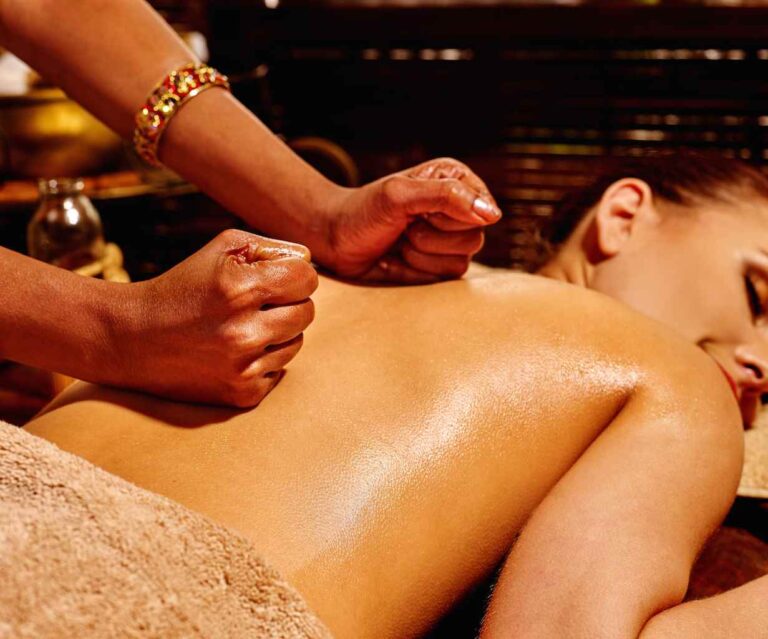Ayurvedic massage, an integral part of Ayurveda, the ancient Indian system of medicine, is renowned for its ability to promote holistic wellness. This guide delves into the best Ayurvedic massage practices, highlighting their principles, benefits, techniques, and how to choose the right one for your needs. Whether you’re seeking relaxation, stress relief, or therapeutic benefits, understanding Ayurvedic massage can significantly enhance your health and well-being.

The Essence of Ayurveda
What is Ayurveda?
Ayurveda, meaning “the science of life,” is a 5,000-year-old system of natural healing rooted in the Vedic culture of India. It emphasizes balance among the mind, body, and spirit and categorizes individuals into three primary doshas: Vata, Pitta, and Kapha. Each dosha governs specific physiological functions and characteristics, and maintaining their balance is crucial for health.
Importance of Doshas in Ayurveda
- Vata Dosha: Associated with air and space, Vata governs movement, breathing, and circulation.
- Pitta Dosha: Comprising fire and water elements, Pitta controls digestion, metabolism, and energy production.
- Kapha Dosha: Consisting of earth and water, Kapha is responsible for structure, strength, and immunity.
Ayurvedic massage therapy aims to restore and maintain the balance among these doshas, promoting overall well-being.

Understanding Ayurvedic Massage
Ayurvedic massage involves the use of specific techniques, herbal oils, and rhythms to balance the doshas, relieve stress, and promote health. It integrates physical manipulation with the use of medicinal oils tailored to the individual’s doshic constitution.
Types of Ayurvedic Massage
- Abhyanga: A full-body massage using warm herbal oils, it nourishes the skin, enhances circulation, and promotes relaxation.
- Shirodhara: Involves a steady stream of warm oil poured onto the forehead, calming the mind and reducing stress.
- Pizhichil: Combines oil and heat therapy by pouring warm oil over the body while massaging, relieving pain and promoting overall health.
- Udvartana: A deep tissue massage using herbal powders, it detoxifies the body and improves skin health.
- Garshana: A dry massage with raw silk gloves that stimulates the lymphatic system and exfoliates the skin.
- Kansu: Focuses on massaging the feet with a small metal bowl, balancing the body’s energies and promoting sleep.
Benefits of Ayurvedic Massage
Physical Benefits
- Improved Circulation: Enhances blood flow and nutrient delivery to tissues.
- Detoxification: Eliminates toxins from the body.
- Pain Relief: Alleviates muscle and joint pain.
- Enhanced Skin Health: Nourishes the skin and improves its texture.
Mental and Emotional Benefits
- Stress Reduction: Reduces stress and anxiety.
- Improved Sleep: Enhances sleep quality by promoting relaxation.
- Mental Clarity: Increases focus and mental clarity.
Spiritual Benefits
- Energy Balance: Balances the body’s energy channels.
- Emotional Release: Promotes emotional healing and well-being.
Choosing the Best Ayurvedic Massage
Understanding Your Dosha
Before selecting an Ayurvedic massage therapy, it’s important to understand your dosha. A qualified Ayurvedic practitioner can help determine your doshic constitution and identify any imbalances that need addressing.
Consultation with a Practitioner
A thorough consultation with an experienced Ayurvedic practitioner is essential. They can recommend the most suitable therapy based on your individual health needs and goals.
Evaluating the Therapist’s Qualifications
Ensure that the therapist has proper certification and training in Ayurvedic massage. Look for practitioners with experience and a good reputation in the field.
Personalization of Treatment
The best Ayurvedic massage therapy is personalized to your specific needs. This includes selecting the appropriate herbal oils, techniques, and duration of the massage.
Reading Reviews and Testimonials
Reading reviews and testimonials from other clients can provide insights into the therapist’s skills and the effectiveness of their treatments.
Integrating Ayurvedic Massage into Your Wellness Routine
Regular Sessions –Incorporating regular Ayurvedic massage sessions into your wellness routine can have long-lasting benefits. Depending on your needs, weekly or monthly sessions may be recommended.
Supporting Lifestyle Practices – Ayurvedic massage therapy works best when combined with other Ayurvedic practices, such as a balanced diet, regular exercise, yoga, and meditation.
Post-Massage Care –After a massage session, it’s important to rest and stay hydrated. Follow any additional recommendations provided by your practitioner, such as dietary changes or herbal supplements.
Conclusion
Ayurvedic massage therapy offers a holistic approach to achieving health and wellness. By understanding your dosha, consulting with a qualified practitioner, and choosing the right type of massage therapy, you can experience the profound benefits of this ancient practice. For more information on Ayurvedic massage therapy and other holistic health practices, visit LifeWin.
